马克吐温写作风格鉴赏(An Analysis of the Writing Styles of Mark Twain)英文版全文
- 格式:doc
- 大小:77.50 KB
- 文档页数:9
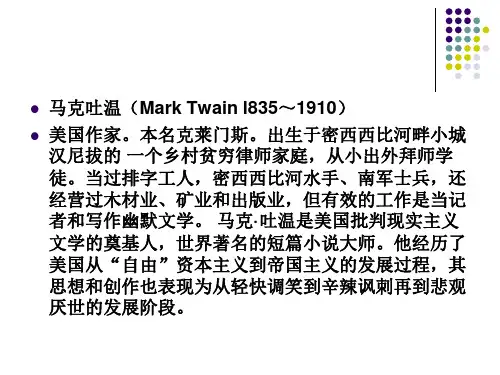
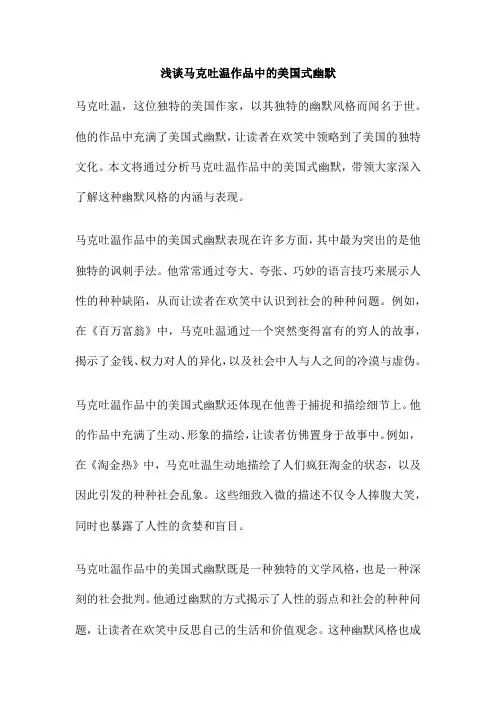
浅谈马克吐温作品中的美国式幽默马克吐温,这位独特的美国作家,以其独特的幽默风格而闻名于世。
他的作品中充满了美国式幽默,让读者在欢笑中领略到了美国的独特文化。
本文将通过分析马克吐温作品中的美国式幽默,带领大家深入了解这种幽默风格的内涵与表现。
马克吐温作品中的美国式幽默表现在许多方面,其中最为突出的是他独特的讽刺手法。
他常常通过夸大、夸张、巧妙的语言技巧来展示人性的种种缺陷,从而让读者在欢笑中认识到社会的种种问题。
例如,在《百万富翁》中,马克吐温通过一个突然变得富有的穷人的故事,揭示了金钱、权力对人的异化,以及社会中人与人之间的冷漠与虚伪。
马克吐温作品中的美国式幽默还体现在他善于捕捉和描绘细节上。
他的作品中充满了生动、形象的描绘,让读者仿佛置身于故事中。
例如,在《淘金热》中,马克吐温生动地描绘了人们疯狂淘金的状态,以及因此引发的种种社会乱象。
这些细致入微的描述不仅令人捧腹大笑,同时也暴露了人性的贪婪和盲目。
马克吐温作品中的美国式幽默既是一种独特的文学风格,也是一种深刻的社会批判。
他通过幽默的方式揭示了人性的弱点和社会的种种问题,让读者在欢笑中反思自己的生活和价值观念。
这种幽默风格也成为了马克吐温作品中最具魅力和最值得我们品味的地方。
通过马克吐温的作品,我们也能更深入地了解美国的文学和文化,以及隐藏在这种幽默背后的美国式价值观。
马克吐温,这位著名作家、演讲家和,以其独特的讽刺和幽默风格而闻名于世。
在本文中,我们将从马克吐温的几篇作品入手,探讨他在讽刺和幽默方面的表现。
在马克吐温的代表作品中,《百万英镑》和《镀金时代》以其轻松的幽默吸引了无数读者。
让我们以《百万英镑》中的一段经典段落为例:亨利·亚当斯,一位普通的美国年轻人,因为偶然的机会被卷入了一场英国贵族的无聊赌局。
他被赠予了一张价值百万英镑的支票。
支票的持有者是一对富有的兄弟,他们为了解决一个争论,想看看一个普通人如何应对这种突如其来的巨大财富。
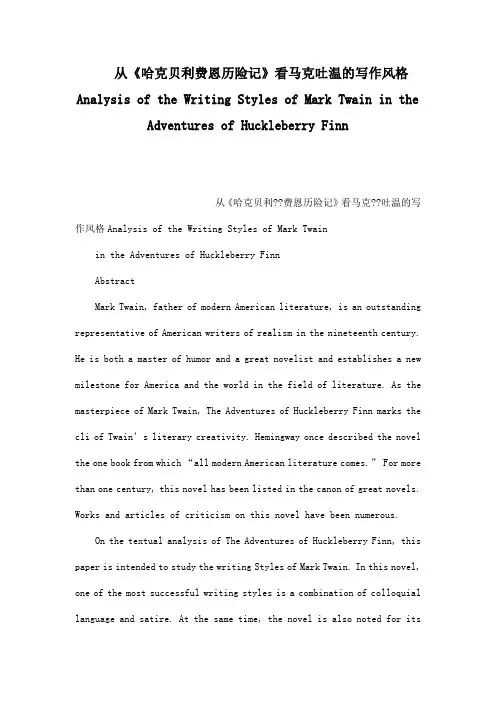
从《哈克贝利费恩历险记》看马克吐温的写作风格Analysis of the Writing Styles of Mark Twain in the Adventures of Huckleberry Finn从《哈克贝利??费恩历险记》看马克??吐温的写作风格Analysis of the Writing Styles of Mark Twainin the Adventures of Huckleberry FinnAbstractMark Twain, father of modern American literature, is an outstanding representative of American writers of realism in the nineteenth century. He is both a master of humor and a great novelist and establishes a new milestone for America and the world in the field of literature. As the masterpiece of Mark Twain, The Adventures of Huckleberry Finn marks the cli of Twain’s literary creativity. Hemingway once described the novel the one book from which “all modern American literature comes.” For more than one century, this novel has been listed in the canon of great novels. Works and articles of criticism on this novel have been numerous.On the textual analysis of The Adventures of Huckleberry Finn, this paper is intended to study the writing Styles of Mark Twain. In this novel, one of the most successful writing styles is a combination of colloquial language and satire. At the same time, the novel is also noted for itsunpretentious, poetic style, wide-ranging humor, and its universally shared dream of perfect innocence and freedom. All these writing styles have been analyzed in this paper.Key Words:Mark Twain; The Adventures of Huckleberry Finn; the writing styles内容摘要马克??吐温(1835―1910)是美国十九世纪伟大的作家,也是美国现实主义文学的杰出代表。
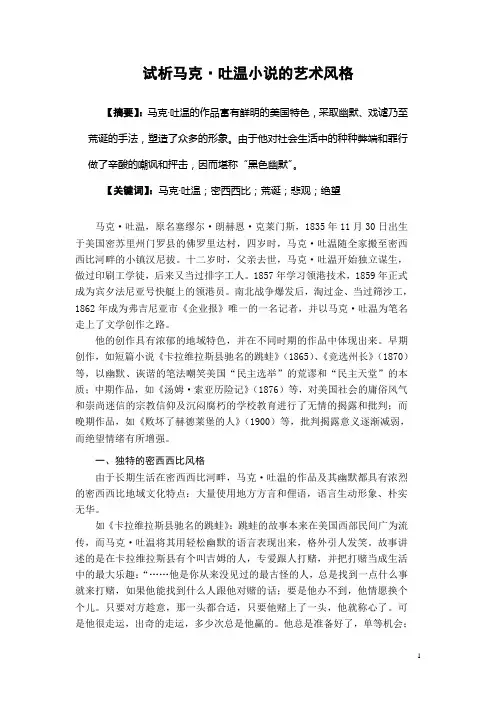
试析马克·吐温小说的艺术风格【摘要】:马克〃吐温的作品富有鲜明的美国特色,采取幽默、戏谑乃至荒诞的手法,塑造了众多的形象。
由于他对社会生活中的种种弊端和罪行做了辛酸的嘲讽和抨击,因而堪称“黑色幽默”。
【关键词】:马克〃吐温;密西西比;荒诞;悲观;绝望马克·吐温,原名塞缪尔·朗赫恩·克莱门斯,1835年11月30日出生于美国密苏里州门罗县的佛罗里达村,四岁时,马克·吐温随全家搬至密西西比河畔的小镇汉尼拔。
十二岁时,父亲去世,马克·吐温开始独立谋生,做过印刷工学徒,后来又当过排字工人。
1857年学习领港技术,1859年正式成为宾夕法尼亚号快艇上的领港员。
南北战争爆发后,淘过金、当过筛沙工,1862年成为弗吉尼亚市《企业报》唯一的一名记者,并以马克·吐温为笔名走上了文学创作之路。
他的创作具有浓郁的地域特色,并在不同时期的作品中体现出来。
早期创作,如短篇小说《卡拉维拉斯县驰名的跳蛙》(1865)、《竞选州长》(1870)等,以幽默、诙谐的笔法嘲笑美国“民主选举”的荒谬和“民主天堂”的本质;中期作品,如《汤姆·索亚历险记》(1876)等,对美国社会的庸俗风气和崇尚迷信的宗教信仰及沉闷腐朽的学校教育进行了无情的揭露和批判;而晚期作品,如《败坏了赫德莱堡的人》(1900)等,批判揭露意义逐渐减弱,而绝望情绪有所增强。
一、独特的密西西比风格由于长期生活在密西西比河畔,马克·吐温的作品及其幽默都具有浓烈的密西西比地域文化特点:大量使用地方方言和俚语,语言生动形象、朴实无华。
如《卡拉维拉斯县驰名的跳蛙》:跳蛙的故事本来在美国西部民间广为流传,而马克·吐温将其用轻松幽默的语言表现出来,格外引人发笑。
故事讲述的是在卡拉维拉斯县有个叫吉姆的人,专爱跟人打赌,并把打赌当成生活中的最大乐趣:“……他是你从来没见过的最古怪的人,总是找到一点什么事就来打赌,如果他能找到什么人跟他对赌的话;要是他办不到,他情愿换个个儿。
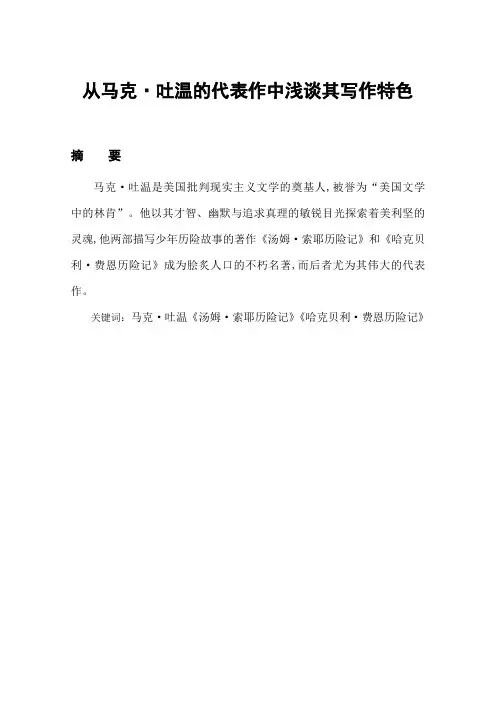
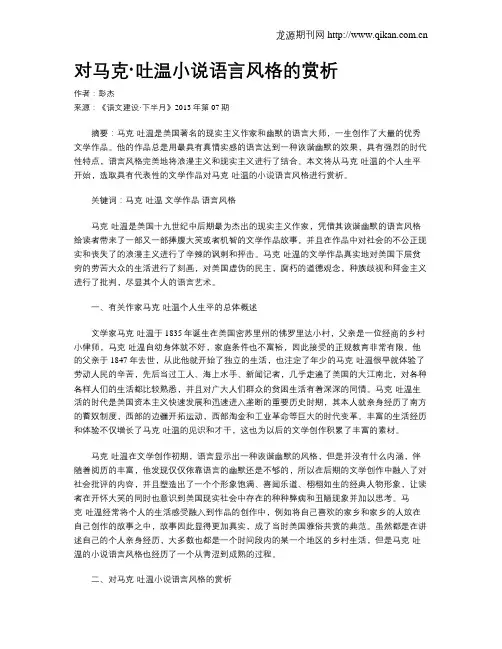
对马克·吐温小说语言风格的赏析作者:彭杰来源:《语文建设·下半月》2013年第07期摘要:马克·吐温是美国著名的现实主义作家和幽默的语言大师,一生创作了大量的优秀文学作品。
他的作品总是用最具有真情实感的语言达到一种诙谐幽默的效果,具有强烈的时代性特点,语言风格完美地将浪漫主义和现实主义进行了结合。
本文将从马克·吐温的个人生平开始,选取具有代表性的文学作品对马克·吐温的小说语言风格进行赏析。
关键词:马克·吐温文学作品语言风格马克·吐温是美国十九世纪中后期最为杰出的现实主义作家,凭借其诙谐幽默的语言风格给读者带来了一部又一部捧腹大笑或者机智的文学作品故事,并且在作品中对社会的不公正现实和丧失了的浪漫主义进行了辛辣的讽刺和抨击。
马克·吐温的文学作品真实地对美国下层贫穷的劳苦大众的生活进行了刻画,对美国虚伪的民主,腐朽的道德观念,种族歧视和拜金主义进行了批判,尽显其个人的语言艺术。
一、有关作家马克·吐温个人生平的总体概述文学家马克·吐温于1835年诞生在美国密苏里州的佛罗里达小村,父亲是一位经商的乡村小律师,马克·吐温自幼身体就不好,家庭条件也不富裕,因此接受的正规教育非常有限。
他的父亲于1847年去世,从此他就开始了独立的生活,也注定了年少的马克·吐温很早就体验了劳动人民的辛苦,先后当过工人、海上水手、新闻记者,几乎走遍了美国的大江南北,对各种各样人们的生活都比较熟悉,并且对广大人们群众的贫困生活有着深深的同情。
马克·吐温生活的时代是美国资本主义快速发展和迅速进入垄断的重要历史时期,其本人就亲身经历了南方的蓄奴制度,西部的边疆开拓运动,西部淘金和工业革命等巨大的时代变革。
丰富的生活经历和体验不仅增长了马克·吐温的见识和才干,这也为以后的文学创作积累了丰富的素材。
马克·吐温在文学创作初期,语言显示出一种诙谐幽默的风格,但是并没有什么内涵,伴随着阅历的丰富,他发现仅仅依靠语言的幽默还是不够的,所以在后期的文学创作中融入了对社会批评的内容,并且塑造出了一个个形象饱满、喜闻乐道、栩栩如生的经典人物形象,让读者在开怀大笑的同时也意识到美国现实社会中存在的种种弊病和丑陋现象并加以思考。
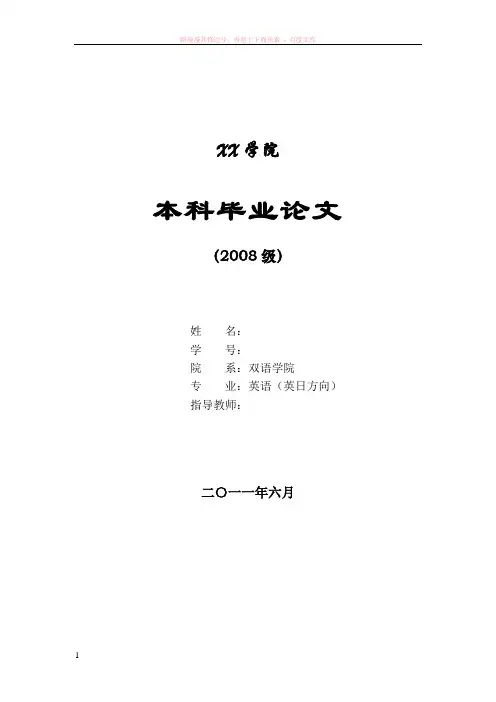
路漫漫其修远兮,吾将上下而求索- 百度文库XX学院本科毕业论文(2008级)姓名:学号:院系:双语学院专业:英语(英日方向)指导教师:二〇一一年六月An Analysis of Mark Twain’s Writing Techniques in The Adventures of Tom Sawyer简析马克吐温在《汤姆索亚历险记》中使用的写作手法姓名:学号:院系:双语学院专业:英语(英日方向)指导教师:吉林华桥外国语学院Jilin HuaQiao Foreign Languages InstituteContentI. Introduction (1)Ⅱ. Mark Twain and The Adventure of Tom Sawyer (1)2.1 Mark Twain’s Life Experience (1)2.2 A Brief Introduction of The Adventures of Tom Sawyer (2)Ⅲ. Writing Techniques Reflected in the Work (4)3.1 Humor (4)3.2 Satire (5)3.3 Colloquial Language (6)3.3.1 Local Color (7)3.3.2 Vernacular Language (7)3.4 Figures of Speech (8)3.4.1 Exaggeration (8)3.4.2 Metaphor (9)3.4.3 Transferred epithet (10)3.4.4 Metonymy (10)ⅣConclusion (11)Bibliography (12)AbstractMark Twain, a mastermind of humor and satire, is seen as a giant in world literature. His humor had great impact on the following men of letters. He produced the world famous juvenile work The Adventure of Tom Sawyer which reflected his own life experience. He produced countless successful works loved by people form different countries. Until today, his works are still read by people all over the world. The thesis presents some of the writing features which contributed to his success such as humor, satire colloquial language and various figures of speech and some of the illustrations from the work.The thesis consists of four parts. The first part of the body tells the life experience of Mark Twain and his famous work The Adventure of Tom Sawyer. The part following, which is also the theme that is discussed in the thesis, is a detailed analysis to some of the writing techniques such as humor, satire which Mark Twain applied in his work. This part specifically states how he created a vivid and expressive image to his readers with the application of the writing techniques and what kind of effects he achieved through this by some of the examples from Twain’s work. The last part is a conclusion of the achievements and brilliance Mark Twain have got. Mark Twain depicts the real world around him with vivid and animated words which shows his true feelings to the world.Key Words: Mark Twain; Tom Sawyer; writing techniques摘要美国的幽默大师和现实主义作家马克·土温,被看作一位世界文学巨匠。

马克吐温写作风格马克吐温的写作风格分为三阶段:一:轻松、幽默、愉快。
二:笔锋辛辣讽刺。
三:悲观,带有厌世情绪。
马克·吐温是19世纪后期美国批判现实主义文学的代表,在不同时期,其作品风格迥异,从最初的轻松幽默到尖酸讽刺,最后陷入绝望与强烈。
美国从自由竞争资本主义向帝国主义的转变,加上马克·吐温个人坎坷的人生路程,都对其写作风格的变化造成很大影响。
原名萨缪尔·朗赫恩·克莱门斯,19世纪美国现实主义文学的杰出代表,是美国著名的幽默大师、小说家、作家、亦是著名演说家。
因其创造性地将文学创、将文学语言“国有化”,被誉为“真正的美作“美国化”。
马克·吐温的写作特点广泛,融幽默讽刺于国文学之父”一体,既富有独特的人性思考,又不乏深刻的社会剖析,调侃中带有辛辣的讽刺与悲天悯人的情感。
马克·吐温写作风格的改变:(一)马克·吐温早期作品风格:马克·吐温在内战时期开始他的创作生涯,早期的作品一般为浪漫、幽默、轻快的风格。
1865年他凭借《卡拉维拉斯县驰名的跳蛙》一举成名,赢得了幽默家的称誉。
这部作品讲述了一个赌徒的轶事,形象地展示了当时正处于开发时期的美国西部地区的特殊风情,表现出纯粹的美,作者扮国气质。
1869年马克·吐温发表《傻子出国记》演无知的美国人,嘲笑欧洲的封建残余和宗教愚昧。
从其早期的创作可以看出,这位表面上轻松嬉笑、想象力丰富的幽默作家,其实是一位严肃的社会批评家。
他的幽默所包含的滑稽诙谐以及他常运用的极度夸张的手法,是一种揭露现实的手段,同时又富于生活气息,深受读者喜爱。
在这一时期的作品凸显了马克·吐温作为幽默大师的才能。
抓住社会黑暗的一面加以尖酸地讽刺和批评,尽管它只是一个笑话,语言轻快、幽默,但他写作主题还是相当严肃的。
总之,在吐温的早期作品中,写作风格的基调是轻快、积极向上以及幽默的。
(二)马克·吐温中期作品风格:在马克·吐温创作中期,他作品的写作风格由早期的幽默、乐观到辛辣讽刺再到更为尖酸讽刺。

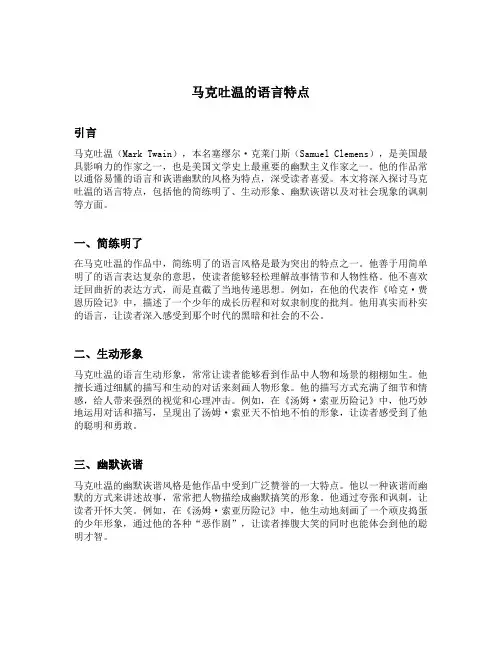
马克吐温的语言特点引言马克吐温(Mark Twain),本名塞缪尔·克莱门斯(Samuel Clemens),是美国最具影响力的作家之一,也是美国文学史上最重要的幽默主义作家之一。
他的作品常以通俗易懂的语言和诙谐幽默的风格为特点,深受读者喜爱。
本文将深入探讨马克吐温的语言特点,包括他的简练明了、生动形象、幽默诙谐以及对社会现象的讽刺等方面。
一、简练明了在马克吐温的作品中,简练明了的语言风格是最为突出的特点之一。
他善于用简单明了的语言表达复杂的意思,使读者能够轻松理解故事情节和人物性格。
他不喜欢迂回曲折的表达方式,而是直截了当地传递思想。
例如,在他的代表作《哈克·费恩历险记》中,描述了一个少年的成长历程和对奴隶制度的批判。
他用真实而朴实的语言,让读者深入感受到那个时代的黑暗和社会的不公。
二、生动形象马克吐温的语言生动形象,常常让读者能够看到作品中人物和场景的栩栩如生。
他擅长通过细腻的描写和生动的对话来刻画人物形象。
他的描写方式充满了细节和情感,给人带来强烈的视觉和心理冲击。
例如,在《汤姆·索亚历险记》中,他巧妙地运用对话和描写,呈现出了汤姆·索亚天不怕地不怕的形象,让读者感受到了他的聪明和勇敢。
三、幽默诙谐马克吐温的幽默诙谐风格是他作品中受到广泛赞誉的一大特点。
他以一种诙谐而幽默的方式来讲述故事,常常把人物描绘成幽默搞笑的形象。
他通过夸张和讽刺,让读者开怀大笑。
例如,在《汤姆·索亚历险记》中,他生动地刻画了一个顽皮捣蛋的少年形象,通过他的各种“恶作剧”,让读者捧腹大笑的同时也能体会到他的聪明才智。
3.1 幽默的对话马克吐温擅长创造出让人忍俊不禁的对话,这是他幽默诙谐的一大表现形式。
他的对话经常带有讽刺意味,有时候是人物之间的互相嘲笑,有时候是对社会现象的嘲讽。
这种幽默的对话使得他的作品更加生动有趣,也更容易引起读者的共鸣。
例如,在《大河上下》中,他通过对主人公和其他人物之间的对话,讽刺了那个时代的虚伪和贪婪。
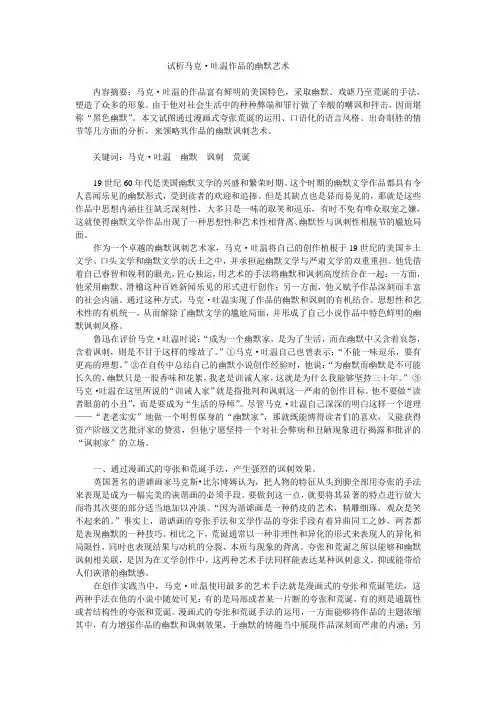
试析马克·吐温作品的幽默艺术内容摘要:马克·吐温的作品富有鲜明的美国特色,采取幽默、戏谑乃至荒诞的手法,塑造了众多的形象。
由于他对社会生活中的种种弊端和罪行做了辛酸的嘲讽和抨击,因而堪称“黑色幽默”。
本文试图通过漫画式夸张荒诞的运用、口语化的语言风格、出奇制胜的情节等几方面的分析,来领略其作品的幽默讽刺艺术。
关键词:马克·吐温幽默讽刺荒诞19世纪60年代是美国幽默文学的兴盛和繁荣时期。
这个时期的幽默文学作品都具有令人喜闻乐见的幽默形式,受到读者的欢迎和追捧。
但是其缺点也是显而易见的,那就是这些作品中思想内涵往往缺乏深刻性,大多只是一味的取笑和逗乐,有时不免有哗众取宠之嫌,这就使得幽默文学作品出现了一种思想性和艺术性相背离、幽默性与讽刺性相脱节的尴尬局面。
作为一个卓越的幽默讽刺艺术家,马克·吐温将自己的创作植根于19世纪的美国乡土文学、口头文学和幽默文学的沃土之中,并承担起幽默文学与严肃文学的双重重担。
他凭借着自己睿智和锐利的眼光,匠心独运,用艺术的手法将幽默和讽刺高度结合在一起:一方面,他采用幽默、滑稽这种百姓新闻乐见的形式进行创作;另一方面,他又赋予作品深刻而丰富的社会内涵。
通过这种方式,马克·吐温实现了作品的幽默和讽刺的有机结合、思想性和艺术性的有机统一,从而解除了幽默文学的尴尬局面,并形成了自己小说作品中特色鲜明的幽默讽刺风格。
鲁迅在评价马克·吐温时说:“成为一个幽默家,是为了生活,而在幽默中又含着哀怨,含着讽刺,则是不甘于这样的缘故了。
”①马克·吐温自己也曾表示:“不能一味逗乐,要有更高的理想。
”②在自传中总结自己的幽默小说创作经验时,他说:“为幽默而幽默是不可能长久的,幽默只是一股香味和花絮,我老是训诫人家,这就是为什么我能够坚持三十年。
”③马克·吐温在这里所说的“训诫人家”就是指批判和讽刺这一严肃的创作目标。
简析马克吐温在《汤姆索亚历险记》中使用的写作手法英语毕业论文本科毕业论文简析马克吐温在《汤姆索亚历险记》中使用的写作手法An Analysis of Mark Twain’s Writing Techniques in The Adventures of Tom Sawyer毕业设计(论文)原创性声明和使用授权说明原创性声明本人郑重承诺:所呈交的毕业设计(论文),是我个人在指导教师的指导下进行的研究工作及取得的成果。
尽我所知,除文中特别加以标注和致谢的地方外,不包含其他人或组织已经发表或公布过的研究成果,也不包含我为获得及其它教育机构的学位或学历而使用过的材料。
对本研究提供过帮助和做出过贡献的个人或集体,均已在文中作了明确的说明并表示了谢意。
作者签名:日期:指导教师签名:日期:使用授权说明本人完全了解大学关于收集、保存、使用毕业设计(论文)的规定,即:按照学校要求提交毕业设计(论文)的印刷本和电子版本;学校有权保存毕业设计(论文)的印刷本和电子版,并提供目录检索与阅览服务;学校可以采用影印、缩印、数字化或其它复制手段保存论文;在不以赢利为目的前提下,学校可以公布论文的部分或全部内容。
作者签名:日期:学位论文原创性声明本人郑重声明:所呈交的论文是本人在导师的指导下独立进行研究所取得的研究成果。
除了文中特别加以标注引用的内容外,本论文不包含任何其他个人或集体已经发表或撰写的成果作品。
对本文的研究做出重要贡献的个人和集体,均已在文中以明确方式标明。
本人完全意识到本声明的法律后果由本人承担。
作者签名:日期:年月日学位论文版权使用授权书本学位论文作者完全了解学校有关保留、使用学位论文的规定,同意学校保留并向国家有关部门或机构送交论文的复印件和电子版,允许论文被查阅和借阅。
本人授权大学可以将本学位论文的全部或部分内容编入有关数据库进行检索,可以采用影印、缩印或扫描等复制手段保存和汇编本学位论文。
涉密论文按学校规定处理。
略论马克.吐温小说叙事风格摘要马克·吐温是美国19世纪中后期杰出的作家,其叙事风格不但继承了传统小说的写法,而且又有其独特的叙事艺术。
本文通过叙述层次、叙述声音、叙述语式对马克·吐温小说的叙事模式进行讨论,从中体会其丰富的话语蕴涵以及其中的审美韵味。
关键词:马克·吐温小说叙事风格中图分类号:i106 文献标识码:a美国19世纪后期著名小说家马克·吐温,在叙事把握上有特殊的悟性,如他喜欢塑造多元角色的人物,创造丰富的话语意蕴,并运用特殊的视角来讲故事。
这些都使马克·吐温在叙事风格方面具有独特的创造性。
一完整的叙述层次叙述层次,也称“叙述结构”,是指在叙述行动中,若出现若干个叙述者时,他们分别所讲的故事之间是什么关系。
有学者将叙述者以“主叙述”为中心,分为“高、低”层和“超叙述”的各种分层。
马克·吐温的小说,多数是由一个叙述层贯穿到底的,如《哈克贝利·芬历险记》等。
但在其小说形式方面,叙述层次又有很多变化,如《苦行记》。
1 主叙述中有次叙述主叙述层中包容着某些低层次叙述,这在马克·吐温的早期少数小说中可见,马克·吐温在他的小说中引入他人所讲的故事,目的是为他的边疆经历增加一些传奇色彩。
如在《苦行记》中,主叙述者是以“我”的身份出现的,在小说的后面引入了“我”听到了吉姆·布莱恩所讲的“老山羊的故事”:“说我应该去找一个叫吉姆·布莱恩的人给我讲一讲他爷爷的老山羊,……他们轻声地说:“嘘!别说了,他就要开讲了。
”另外,在《苦行记》后面部分,马克·吐温以同样手法引入了迪克·贝克讲的“猫的故事”。
从这里我们可以看到,在马克·吐温的小说里虽然用了叙述分层,但却没有不同价值观的冲突。
他巧妙地在主叙述中用”我”这一人物打开了另一个叙述层面。
2 超叙述层设计所实现的叙事效果超叙述的作用,是使同时具有两种身份的、主叙述层中的叙述接受者和超叙述层中的叙述者“我”,非常自然地产生作为一个叙述接受者的心理认同,使读者产生等着听故事的强烈心理期待。
马克吐温小说中幽默风格的研究马克·吐温是美国文坛中杰出的文学巨匠、幽默大师,被尊称为美国文学之父。
幽默风趣是他文笔比较突出的特点,与此同时,他还比较善于运用各种各样的写作技巧来揭露美国最真实的社会现象。
本文主要对马克·吐温小说中的幽默风格进行讲解和分析。
作者将会以马克·吐温的经典作品《哈克贝里·费恩历险记》来具体分析其中所蕴含的幽默艺术气息,从而让更多爱好者深入的认识和了解他的写作风格。
一、马克吐温小说中幽默风格的来源马克·吐温是十九世纪美国批判现实主义文学的代表家,也是美国批判现实主义文学的奠基人。
他从小受生活环境的严重影响,随着社会环境的转变,他的主题思想和创作风格都遭受到很大的改变,他的笔风从以前的轻松、幽默风格逐渐转变为讽刺、悲观的风格。
美国文学史上,他是唯一一个在作品中使用完全、纯粹口语的小说家,鲜明的主题思想蕴藏在他的作品中,通过使用幽默、滑稽和诙谐的语言,揭露美国资本主义社会中存在的很多矛盾与问题,并将血肉模糊的残酷现实展现在世人面前。
只要是读过他的作品,你就不难发现,马克吐温的大部分作品都难以抹去幽默的痕迹。
然而,在幽默的背后,你肯定会发现一个最重要的问题,他那幽默的写作风格肯定不只是为了博得读者们的微微一笑,更多的是对那些令人心酸幽默背后所隐含的讽刺与无奈应该都会有所领悟。
现实生活中,我们也会遇到几个充满幽默感的人,也许就是我们现在所说的开心果类似的人,如果在进行创作时能把幽默作为一种写作风格,一定是一件很不容易的事情,因为作品中的幽默不能只是让笑笑就够了,,而是要让人们通过这个幽默看到真正的内涵所在,并能够对此有所领会和感悟。
二、透过《哈克贝里·费恩历险记》分析其中的幽默艺术马克·吐温,作为世界闻名的幽默大师,他创作了大量的文学作品,经常会运用的语言风格主要是以幽默为主,当然还有讽刺意味存在。
相比于传统文学作品,他的文学作品摆脱了传统文学语言模式的限制,他经常会在他的作品中恰当地加入部分美国俚语以及地方性方言等口语化内容,极大地提升了文学作品的幽默感。
Analysis of writing style of Mark TwainMark Twain was the first important writer to consistently use the Ameri can speech rather than England’s English. His honor, whether it was aim ed at pure entertainment or at social satire, was irresistible. His realism, and details influenced many later American novelists. That was why Erne st Hemingway once said “all modern American literatures came from one book written by Mark Twain called The Adventures of Huckleberry Fin n.”And it became Twain’s masterpiece. Mark Twain’s three years’life on that returned to the Mississippi left such a fond memory with him that r eturned to the theme more than once in his writing career.Huckleberry Finn is a veritable recreation of living models, and is Huc k’s book, not Jim’s. The two major characters, Huck and Jim, represent the two sides of the dilemma: Huck strikes out for an absolute freedom, while Jim requires, in order to gain his own freedom, that Huck qualify his freedom by entering into the pursuit of Jim’s. It starts out as a come dy , an ‘As You Like It’with a hero drawn from the bottom of society ra ther than the top. Huck and his father, Jim, the swindlers(the Duke and the Dauphin), colonel sherburn and the drunkard Boggy-all these charact ers prototypes in real life. The portrayal of individual incidents and chara cters achieved intense verisimilitude of detail. Serious problems are being discussed through the narration of a little illiterate boy. The fact that the wilderness juxtaposed with civilization, the people half wild and half civili zed, many of whom are worse, vulgar, are brutal. As for the style of the book, the form is based on the simplest of all novel-forms, the so-calle d picaresque novel, or novel of the road, which strings its incidents on t he line of the hero’s travels. But, in this novel, rivers are roads that mov e, and the movement of the road in its own mysterious life transmutes t he primitive simplicity of the from: the road itself is the greatest characte r in this novel of the road, and the hero’s departures from the river andhis returns to it compose a subtle and significant pattern. The Adventur es of Huckleberry Finn shows us the major achievements of his art: the masterful use of dialects; humor and pathos, innocence and evil. This no vel demonstrates his ability to capture the enduring, archetypal, mythic i mages of America and to create the most memorable characters in all of American fiction.2.1 Use of Colloquial LanguageThe book is written in a colloquial style, in the general standard speec h of uneducated Americans. Moreover, the prose of Huckleberry Finn est ablished the prose virtues of American colloquial speech. It has somethin g to do with ease and freedom in the use of language. Most of all, it h as to do with the structure of the sentence, which is simple, direct, and fluent, maintaining the rhythm of the word’s group of speech and the int onations of the speaking voice. Mark Twain’s colloquial style has influenc ed a large number of American writers.The Adventures of Huckleberry Finn displays the major achievements of his art: the carefully controlled point of view, with its implicit ironies e xpressed through the voice of a semiliterate boy: the masterful use of di alects: the felicitous balancing of nostalgic humorist and realism, humor and pathos, innocence and evil, all united for a journey down the Missis sippi that serves as the mythic center of the novel. This novel demonstr ates his ability to capture the enduring, archetypal, mythic images of Am erica and to create the most memorable characters in all of American fic tion.2.1.1 Vernacular LanguageMark Twain wrote in his unpretentious, colloquial, and poetic style. He used vernacular language, dialect with spelling representing pronunciatio n. Part of this comes from his interest in humor. The directness of the l anguage is a very influential point in Twain’s style. Ernest Hemingway in the 20th century said that he had learnt his craft from Mark Twain because if the direct speech and the direct narration that Twain was able to achieve. The hoax and tall tale are also part of twain’s style. Hoax is wr iting something fantastic and pretending that it were true, much like the t all tale. It tolls as if it were true, and so the reader would laugh that an y body could believe such preposterous things, the burlesque making fun of establishes ways of writing.Mark Twain said, “I amend dialect stuff by talking and talking it till it s ounds right.”He wanted his writing to have the sound of easy-going spe ech. In Huckleberry Finn the fountainhead of the American colloquial pro se, he wrote seven different dialects and each can be distinguished. If t he reader is a linguist, he can examine the different pronunciations that Twain has shown. In his own time, dialect writing was considered humor ous. People got a big laugh out of reading these misspell words. Anothe r feature of the book, which helps to make it famous is its language. The book is written in the colloquial style in the general standard speech of uneducated Americans.. Mark Twain’s introductory note on accents is a n indication of his conscious attempt to achieve accurate detail. “In this book,”he says, “a number of dialects are used, to wit: the Missouri Neg ro dialect; the extreme forms of the backwoods southwestern dialect; the ordinary ‘pike country’dialect; and four modified varieties of this last. T he shadings have not been done in a haphazard fashion, or by guesswo rk; but painstakingly, and with the trustworthy guidance and support of p ersonal familiarity, with these several forms of speech.”“Painstaking ”an d “not haphazard,”though they possess a humorous ring, denote the co nscientious effort on the part of the author, and trustworthiness and famil iarity and the author’s awareness of dialects in using which reveal his at tempt to reproduce actual daily speech with a degree of accuracy. A rec ent and very influential recasting of Huck’s vernacular voice has identifie d.We may quote a passage from this masterpiece as an illustration:“I took the sack of corn meal and took it to where the canoe was hid, and shoved the vines and branches apart and put it in; then I done th e same with the side of bacon; then the whisky-jug. I took all the coffee and sugar there was, and all the ammunition; I took the wadding; I too k the bucket and gourd; took a dipper and a tin cup, and my old son a nd two blankets, and the skillet and the coffee-pot/ I took fish lines and matches and other things- everything that was worth a cent. I cleaned o ut the place I wanted an ax, but there wasn’t any, only the one out at woodpile, and I know why I was going to leave that. I fetched out the g un, and now I was done.”The words used here are, perhaps “ammunition”which is etymologicall y French, mostly Anglo-Saxon in origin, and are short, concrete and dire ct in effect. Sentence structures are most of them simple or compound, with a series of “then”and “ands”and semi-colons serving as connective s. The repetition of the word “took”and the stringing together of things l eave the impression that Mark Twain depend solely on the concrete obje ct and action for the body and movement of his prose. What is more, th ere is an ungrammatical element, which gives the final finish to his style. The whole book approximates the actual speech habit of an uneducate d boy from south American of the mid-nineteenth century.The vernacular language in the Adventures of Huckleberry Finn initiate d the new style of language in American novels, and has had significant influence upon American writers of later generations.2.1.2 Local ColorLocal color as a trend first made its presence in the late 1860s and e arly seventies. The vogue of local color fiction was, the logical combinati on of a long, progressive development. It was the outgrowth of historical and aesthetic forces that been gathering energy since early nineteenthcentury. Twain refers to the elements, which characterize a local culture, elements such as speech, customs, and also a particular place. Local c olorists concerned themselves with presenting and interpreting the local c haracter of their regions. They tended to identify and glorify, but they ne ver forgot to keep an eye on the truthful color of local life.Twain depicted social life through descriptions of local places and peo ple he knew best and believed that “the most valuable capital, or culture, or education usable in the building of novels is personal experience.”Y et, sometimes Twain wrote a sentimental story, not because he was sen timental, but because he wanted to show the reader how stupid such a story really was. The reader has to be very careful when he or she rea ds Mark Twain. Twain often played trick on the reader. He often said thi ngs when he meant just the opposite. This is the irony that he got the humor from the Far West. He would do things that he did just to mak e fun , but the reader might think that he really meant it. Then the read er was the tender-foot who taken in .Mark twain preferred to respect social life through portraits of local pla ces which he knew best and drew heavily from his own rich fund of kno wledge of people and places. The Adventures of huckleberry Finn is one such example. Finn is living breathing personality. It is through his use of language and his activities that Twain creates character and sets dow n objective truth: Finn is uneducated; he dislikes civilized ways because they are restrictive and hypocritical he likes.Meanwhile, local color mixed romantic plots with realistic descriptions o f things which were readily observed, with the customs , dialects, sights, smell and sounds of regional America. After the Civil war, local color h ad further developed, In this book, this kind of literature mainly describes the local life, the keynote was optimistic, and the language was narrativ e humorous. The characters he created were humorous and full of wittin ess. Mark Twin’s work was regarded the witness of America’s pure locallife. According to Calkins, “Few American writers have written the same after reading telling.”From my point of view, American literature is so c harming for this kind of works.Local color became dominate in American Literature(1860-1870). One of the most important writing features of Mark Twain is the use of Local colorism. It is also impossible in the Mississippi River towns through wh ich Huck and Jim journey to imagine being a hero .This in turn makes Sherborn a cold-blooded killer and Huck a saint (and Tom a good). Let me repeat it as a saint,however, Huck is no more bent on social refor m, no more optimistic about it, than is sherburn. So local colorism is a variation of American realism, and also a description of a small refined r egion. Twain, breaking out of the narrow limits of local-color fiction, desc ribed the breadth of American experience as no one had ever done befo re, or since, and he created The Adventures of Huckleberry Finn,a mas terpiece of American realism that proverbs to be one of the great books of world literature.2.1.3 PunIn English paronomasia called pun, means call by a different name. T he exact definition is: Humorous use of word to suggest different meanin gs, or of words of same or similar sound has different meanings. There are five forms of pun: homophonic pun, paranomasic, antalaclasis, sylleti c pun, asteismus. In a certain context, pun has several pragmatic functio ns. Throughout all of Twain’s writing, we see the conflict between the id eals of Americans and their desire for money. But Twain never tried to solve the conflict. He is like a newspaperman who reports what he sees. In this situation, his humor was often rather childish. This may bespeak why the critic P. Abel said:”Twain was a boy and an old man, but nev er was he a man.”In The Adventures of Huckleberry Finn,we can find many words and phrases that were used vividly to describe the things that happened, such as ‘I went along slow then, and I wasn’t right down certain whether I was glad I started or whether I wasn’t. This sentence is very interesting; pun is used to express the author’s mood at that moment. We can als o use another kind of language to replace the original, but the effect is so different. So we can conclude that pun played an important role in th is novel.。
An Analysis of the Writing Styles of Mark TwainHis colloquial Language and Satire in the Adventures of Huckleberry FinnI. The Background of Mark Twain1.1 Mark Twain and His ExperienceMark Twain, pseudorym of Samuel langhone Clemens, was brought up in the town of Hannibal, Missouri, near the Mississippi River. He was twelve when his father diod and he had to leave school. He was successively a printer’s apprentice, a tramp printer, a silver miner, a steamboat pilot on the Mississippi, and a frontier journalist in Nevada and California. This knocking about gave him a wide knowledge of humanity. As one of America’s first and foremost realists and humorists, Mark Twain usually wrote about his own personal experiences and things he knew about from firsthand experience. His life spanned the two Americas, the frontier America and the emerging urban, industrial giant of the twenty-century.As a witness of the civil war, Twain saw clearly the great changes in nation’s economic development and political life. With the final victory over the South the North once again enjoyed its wielding power in the nation’s administration. Now the acute conflict at home was undermined and the American people again focused their full attention on re-construction after the war. Because most majority of the slaves were emancipated, the slave-based economy of the defeated South had its prosperity became rootless. In this case, clusters of groundless southern poor whites and the newly freed slaves headed directly of indirectly for the new-liberated cities to seek opportunities. It may be called the ‘Gold Rush’ rejuvenated, or rather, it was so-called the ‘American Dream’ by some critics. Twain also could not help rushing to the west to will his American dream. He once believed the idea of development and industrialization since it would modernize the young country and encourage the enterprising spirit of the American who had long been famous for it. He was firmly enthralled by such fever, so once again he held an optimistic attitude towards the post-westward expansion. He drew much inspiration from the unparalleled and magnificent event and spoke highly of its decision-makers and its people.1.2 The Adventures of Huckleberry FinnThe best work that Mark Twain ever produced is, as we noted earlier on, The Adventures of Huckleberry Finn. It tells a story about the United States before the Civil War, around 1850, when the great Mississippi Valley was still being settled. Here lies an America, with its great national faults, full of violence and even cruelty, yet still retaining the virtues of ‘some simplicity, some innocence, and some peace.’ The story takes place along the Mississippi River, on both sides of which there was unpopulated wilderness and a dense forest. It relates the story of the escape of Jim from slavery and, more important, how Huck Finn, floating along with him and helping him as best he could, changes his mind, his prejudice about black people, and comes to accept Jim as a man and as a close friend as well.At the heart of Twain’s achievement is his creation of Huck Finn, who embodies that mythic America, midway between the wilderness and the modern super state.1.3 A General Introduction to the MississippiThe Mississippi is not only Mark Twain’s life stage but also American society’s stage. It flows through the middle of America; it’s one of the greatest rivers in the world. In Twain’s early years, the geographic core was the great valley of the Mississippi River, and the Mississippi is the main ar tery of transportation on the young nation’s heart. In 1857, young Mark Twain entered thatworld as a cub pilot on a steamboat. Later, when he wented to write something, this land provided him with many plentiful writing materials.II. Analyzing Two Writing Styles of Mark Twain (in the Adventures of Huckleberry Finn) Mark Twain was the first important writer to consistently use the American speech rather than England’s English. His honor, whether it was aimed at pure entertainment or at social satire, was irresistible. His realism, and details influenced many later American novelists. That was why Ernest Hemingway once said “all modern American literatures came from one book written by Mark Twain called The Adventures of Huckleberry Finn.” And it became Twain’s masterpiece. Mark Twain’s three years’ life on that returned to the Mississippi left such a fond memory with him that returned to the theme more than once in his writing career. Huckleberry Finn is a veritable recreation of living models, and is H uck’s book, not Jim’s. The two major characters, Huck and Jim, represent the two sides of the dilemma: Huck strikes out for an absolute freedom, while Jim requires, in order to gain his own freedom, that Huck qualify his freedom by entering into the pursui t of Jim’s. It starts out as a comedy , an ‘As You Like It’ with a hero drawn from the bottom of society rather than the top. Huck and his father, Jim, the swindlers(the Duke and the Dauphin), colonel sherburn and the drunkard Boggy-all these characters prototypes in real life. The portrayal of individual incidents and characters achieved intense verisimilitude of detail. Serious problems are being discussed through the narration of a little illiterate boy. The fact that the wilderness juxtaposed with civilization, the people half wild and half civilized, many of whom are worse, vulgar, are brutal. As for the style of the book, the form is based on the simplest of all novel-forms, the so-called picaresque novel, or novel of the road, which strings its incidents on the line of the hero’s travels. But, in this novel, rivers are roads that move, and the movement of the road in its own mysterious life transmutes the primitive simplicity of the from: the road itself is the greatest character in this novel of the r oad, and the hero’s departures from the river and his returns to it compose a subtle and significant pattern. The Adventures of Huckleberry Finn shows us the major achievements of his art: the masterful use of dialects; humor and pathos, innocence and evil. This novel demonstrates his ability to capture the enduring, archetypal, mythic images of America and to create the most memorable characters in all of American fiction.2.1 Use of Colloquial LanguageThe book is written in a colloquial style, in the general standard speech of uneducated Americans. Moreover, the prose of Huckleberry Finn established the prose virtues of American colloquial speech. It has something to do with ease and freedom in the use of language. Most of all, it has to do with the structure of the sentence, which is simple, direct, and fluent, maintaining the rhythm of the word’s group of speech and the intonations of the speaking voice. Mark Twain’s colloquial style has influenced a large number of American writers.The Adventures of Huckleberry Finn displays the major achievements of his art: the carefully controlled point of view, with its implicit ironies expressed through the voice of a semiliterate boy: the masterful use of dialects: the felicitous balancing of nostalgic humorist and realism, humor and pathos, innocence and evil, all united for a journey down the Mississippi that serves as the mythic center of the novel. This novel demonstrates his ability to capture the enduring, archetypal, mythic images of America and to create the most memorable characters in all of American fiction.2.1.1 Vernacular LanguageMark Twain wrote in his unpretentious, colloquial, and poetic style. He used vernacular language, dialect with spelling representing pronunciation. Part of this comes from his interest inhumor. The directness of the language is a very influential point in Twain’s style. Ernest Hemingway in the 20th century said that he had learnt his craft from Mark Twain because if the direct speech and the direct narration that Twain was able to achieve. The hoax and tall tale are also part of twain’s style. Hoax is writing something fantastic and pretending that it were true, much like the tall tale. It tolls as if it were true, and so the reader would laugh that any body could believe such preposterous things, the burlesque making fun of establishes ways of writing.Mark Twain said, “I amend dialect stuff by talking and talking it till it sounds right.” He wanted his writing to have the sound of easy-going speech. In Huckleberry Finn the fountainhead of the American colloquial prose, he wrote seven different dialects and each can be distinguished. If the reader is a linguist, he can examine the different pronunciations that Twain has shown. In his own time, dialect writing was considered humorous. People got a big laugh out of reading these misspell words. Another feature of the book, which helps to make it famous is its language. The book is written in the colloquial style in the general standard speech of uneducated Americans.. Mark Twain’s introductory note on accents is an indication of his conscious attempt to achieve accurate detail. “In this book,” he says, “a number of dialects are used, to wit: the Missouri Negro dialect; the extreme forms of the backwoods southwestern d ialect; the ordinary ‘pike country’ dialect; and four modified varieties of this last. The shadings have not been done in a haphazard fashion, or by guesswork; but painstakingly, and with the trustworthy guidance and support of personal familiarity, with t hese several forms of speech.” “Painstaking ” and “not haphazard,” though they possess a humorous ring, denote the conscientious effort on the part of the author, and trustworthiness and familiarity and the author’s awareness of dialects in using which rev eal his attempt to reproduce actual daily speech with a degree of accuracy. A recent and very influential recasting of Huck’s vernacular voice has identified. We may quote a passage from this masterpiece as an illustration:“I took the sack of corn me al and took it to where the canoe was hid, and shoved the vines and branches apart and put it in; then I done the same with the side of bacon; then the whisky-jug. I took all the coffee and sugar there was, and all the ammunition; I took the wadding; I took the bucket and gourd; took a dipper and a tin cup, and my old son and two blankets, and the skillet and the coffee-pot/ I took fish lines and matches and other things- everything that was worth a cent. I cleaned out the place I wanted an ax, but there wa sn’t any, only the one out at woodpile, and I know why I was going to leave that. I fetched out the gun, and now I was done.”The words used here are, perhaps “ammunition” which is etymologically French, mostly Anglo-Saxon in origin, and are short, concrete and direct in effect. Sentence structures are most of them simple or compound, with a series of “then” and “ands” and semi-colons serving as connectives. The repetition of the word “took” and the stringing together of things leave the impression that Mark Twain depend solely on the concrete object and action for the body and movement of his prose. What is more, there is an ungrammatical element, which gives the final finish to his style. The whole book approximates the actual speech habit of an uneducated boy from south American of the mid-nineteenth century.The vernacular language in the Adventures of Huckleberry Finn initiated the new style of language in American novels, and has had significant influence upon American writers of later generations.2.1.2 Local ColorLocal color as a trend first made its presence in the late 1860s and early seventies. The vogue oflocal color fiction was, the logical combination of a long, progressive development. It was the outgrowth of historical and aesthetic forces that been gathering energy since early nineteenth century. Twain refers to the elements, which characterize a local culture, elements such as speech, customs, and also a particular place. Local colorists concerned themselves with presenting and interpreting the local character of their regions. They tended to identify and glorify, but they never forgot to keep an eye on the truthful color of local life.Twain depicted social life through descriptions of local places and people he knew best and believed that “the most valuable capital, or culture, or education usable in the building of novels is personal experience.” Yet, sometimes Twain wrote a sentimental story, not because he was sentimental, but because he wanted to show the reader how stupid such a story really was. The reader has to be very careful when he or she reads Mark Twain. Twain often played trick on the reader. He often said things when he meant just the opposite. This is the irony that he got the humor from the Far West. He would do things that he did just to make fun , but the reader might think that he really meant it. Then the reader was the tender-foot who taken in .Mark twain preferred to respect social life through portraits of local places which he knew best and drew heavily from his own rich fund of knowledge of people and places. The Adventures of huckleberry Finn is one such example. Finn is living breathing personality. It is through his use of language and his activities that Twain creates character and sets down objective truth: Finn is uneducated; he dislikes civilized ways because they are restrictive and hypocritical he likes. Meanwhile, local color mixed romantic plots with realistic descriptions of things which were readily observed, with the customs , dialects, sights, smell and sounds of regional America. After the Civil war, local color had further developed, In this book, this kind of literature mainly describes the local life, the keynote was optimistic, and the language was narrative humorous. The char acters he created were humorous and full of wittiness. Mark Twin’s work was regarded the witness of America’s pure local life. According to Calkins, “Few American writers have written the same after reading telling.” From my point of view, American literat ure is so charming for this kind of works.Local color became dominate in American Literature(1860-1870). One of the most important writing features of Mark Twain is the use of Local colorism. It is also impossible in the Mississippi River towns through which Huck and Jim journey to imagine being a hero .This in turn makes Sherborn a cold-blooded killer and Huck a saint (and Tom a good). Let me repeat it as a saint,however, Huck is no more bent on social reform, no more optimistic about it, than is sherburn. So local colorism is a variation of American realism, and also a description of a small refined region. Twain, breaking out of the narrow limits of local-color fiction, described the breadth of American experience as no one had ever done before, or since, and he created The Adventures of Huckleberry Finn, a masterpiece of American realism that proverbs to be one of the great books of world literature.2.1.3 PunIn English paronomasia called pun, means call by a different name. The exact definition is: Humorous use of word to suggest different meanings, or of words of same or similar sound has different meanings. There are five forms of pun: homophonic pun, paranomasic, antalaclasis, sylletic pun, asteismus. In a certain context, pun has several pragmatic functions. Throughout all of Twain’s writing, we see the conflict between the ideals of Americans and their desire for money. But Twain never tried to solve the conflict. He is like a newspaperman who reports what he sees.In this situation, his humor was often rather childish. This may bespeak why the critic P. Abel said:” Twain was a boy and an old man, but never was he a man.”In The Adventures of Huckleberry Finn, we can find many words and phrases that were used vividly to describe the things that happened, such as ‘I went along slow then, and I wasn’t right down certain whether I was glad I started or whether I wasn’t. This sentence is very interesting; pun is used to express the author’s mood at that moment. We can also use another kind of language to replace the original, but the effect is so different. So we can conclude that pun played an important role in this novel.2.2 Satire in The Adventures of Huckleberry FinnSatire is a way of criticizing people or ideas in a humorous way to show that they have faults or are wrong, or a piece of writing or play, which uses this style. In The Adventures of Huckleberry Finn, Twain shows satire on southern culture before the civil war, when the Mississippi valley was still being settled. Twain blended two different subjects, the experience of westward expansion and the experience of southern slavery. And he wrote about both regains of the country. His attitudes toward the south were much less pleasant than his attitudes toward the west, because he confronted the south problem of slave of mistreatment of humans by humans. Through the change of the white boy Huck’s attitude toward Jim, a runaway black slave, Twain condemned racial discrimination. Twain made fun of typical American values, yet underneath he felt a brooding pessimism not only about American valuable but also about life itself. It was a dreadful thing to see Human beings be awful cruel to one another. Due to Twain’s own experience, satire is successfully used in this novel. There’s one sign ificant scene which should be remembered, Huck Finn witnesses many instances of cruelty, brutality and hypocrisy in the township along the river Here are four points about his satire in this novel.2.2.1 VanityVanity in The Adventures of Huckleberry Finn has a perfect embodiment. Twain viewed the poor whites and showed the reader how these no-count whites thought they were better than black slaves. Many share-coppers just able to make enough money to live for these sorts of illusions. Vanity was the only thing that kept them above the slaves. Their standard of living in many cases was beneath that of slaves. The only thing that made them feel good about themselves was that they were white. And Twain made the reader laugh at the ludicrous idea that they were held. For Huck Finn, the journey on the raft with Jim was a voyage of moral discovery. At the early stage, Huck Finn looks upon Jim as a Negro slave with a common attitude. However, as they progress down the river, he changes his mind and no longer has prejudice against black people. He gradually comes to see Jim as a human being and begins to accept him as his friend. Yet Huck Finn never fully succeeds in breaking free from the prevailing attitude towards Negroes. As for this part, it’s a large contra st to the other people. Huck Finn rebels against the atrocious king and duke. He is disgusted with their trifling with human beings. It is because that Huck Finn is such a good and noble person that his moral dilemma in helping a Negro slave to escape constitutes a profound condemnation of the way of life and moral values of American south. His conscience has been formed by the morality of St. Petersburg and he never quite succeeds in freeing himself from that society’s corrupt standards. Huck Finn’s formed conscience is the measure of the moral corruption of the community that shaped. So he sinks into an inner struggle. He becomes increasingly caught between his friendship with Jim and the common social standards. Compare with others, Huck Finn’s goodness i s always unconscious and spontaneous, arising out of thedeepest recesses of his nature. He abuse cares about the welfare of others and cannot bear to see anyone suffer. He shows sympathy for the nicest of Peter Wilks and saves money for them. So the opposite character embodies vanity has come into the stage. However, humor could no more be found in Twain’s biter works. On the contrary, it was replaced by bitter satire, and vanity is an embodiment of Twain’s satire.2.2.2 Unquestioning Acceptance of ViolenceThe second object of satire is the genteel upper-class southerner. The genteel upper-class southerners don’t understand themselves, either. They lived a aristocratic life. In the novel, Granger fords are violent and hateful toward other people. Out of senseless perversion of a code of “honor”, they are involved in a feud, one that has been going on for generations with the shepherd sons. Its cause has been forgotten. Every Sunday, the shepherd sons and the Grange fords go to the same church. The shepherd sons sit on one side of their guns against the wall. And they listen to the preacher talk about brotherly love. When the sermon is over, they pick up their guns and they keep an eye on each other as they walk out the door so they will not get shot in the back. The satire is merciless, not only because these people are violent, but because they accept their violence as right. No one wants to reform. Huck keeps asking “Why?” It is just the way life is. This unquestioning acceptance of violence is the reason why Twain condemned southern society. The destruction and tyranny of Huck Finn’s father are other reasons for his escaping and desiring to be free. Huck Finn’s father is a part of that society with Huck Finn’s wishes. In contract to Miss Watson’s hypocr isy, his father presents the brutality and severity of civilization that threaten to destroy Huck Finn. His father believes that money and education are all the things of that time. Huck didn’t accept the violence from his father. Huck Finn’s freedom is mo dified by the presence of his father’s actions. Living in the woods, his father beats him quite frequently and sometimes leaves him locked up in the cabin for a long time. Once when his father returns from town, he is so drunk that he almost kills him. Huck Finn is mature enough to recognize the danger and only when he becomes convinced that his father represents immediate threat to his life does he decide to escape. Throughout his life plans to escape Huck Finn is more concerned for his life than anything else and prefers simply to disappear and begin a new life. Huck Finn’s desire to be free, at it’s deepest levels, and explores the possibility of an individual achieving true freedom in society. He is constantly forced to flee from a civilized society in order to preserve his sense of integrity and identity. It’s only when he is on the river in the group with Jim that flees secure and nature. Having escaped from the feud, he remarks that there is no home like raft and other places seem to be cramped up and smothery but a raft is. And he feels free and easy and comfortable very much on a raft. It is striking that whenever, Huck Finn comes into contact with the people along the river he is forced to assume a false identity. His initial escapes from his own cruel father and the society of St. Perterburry forces him to feign his own death. Brian Donnelly argues that Huck Finn’s true life could only be achieved by dying in the eyes of the people and by escaping down the Mississippi River. This is the way that Huck chose to the problem: violence.2.2.3 CowardThe violence on which southern culture rests is a pretence or illusion to disguise the basic cowardliness of the people and their refusal to act as individuals. Twain felt it even more deeply. People are vi olent, in Twain’s view, because they are cowards. Things are all mixed up in southern society, in any society, based on violence. It is a society without a leader. Twain’s attack on these people is bitter. In the middle part of this novel, the king and the duke were seriously evil; indeed,the long wilks episode is not funny. Had a lawyer Levi Bell, a precursor of Puddn’s head Wilson, not intervened, the outcome would have been dark in the measure of sherburn; in sherburn’s world there are no good people to be ruined. In Wilkses’ world, however, the good people are so powerless as the coward in Brecksville. The hopeless lambs offer no hope of betterment; they only measure its absence. Huck and Jim had left St. Petersburg with high hopes of freedom that are badly set back at cairo. The Willks episode ends in the utter defeat of these hopes. There seems to be no way to escape the duke and the king, the rest we have already discussed. Jim’s captivity is paralleled by Huck’s in thrall to Tom. It is on the very ve rge of the collapse of all possibility of freedom that Huck places his highest bid for it. Indeed, Jim has already been recaptures when Huck finds himself at last making the decision Twain had not been able to make at Cairo: “It was a close place,” he realizes, “I was a trembling, because I’d got to decide, forever, betwixt two things, and I knew it. I study a minute, sort of holding my breath, and then says to myself:’ All right, then, I’ll go to hell.’” Let us say the obvious: Twain has chosen the route of social engagement when it’s too late in the story to take it. Huck has decided when he is willing to go to hell, but the harder decision was whether to go to Ohio. All in all, Huck is not a coward, those people who want to use violence to attack others can be called coward. During that years, the whole American society upheavaled strongly, and this novel deeply depicted the experience of this kind of person, under Mark Twain’s writing, coward is so vivid to embody the features of that age. We can pay more attention on sherburn, a merchant and a military man, a double pillar of society—but in a society that does not deserve to be supported. On the contrary, it merits being brought crashing down, for all the reasons Huck has been exposing through the incidents of his journey. This is not a deformable society; one can only curse it and leave. Sherburn curse it and stays, and Twain finds himself approving the cursing and not knowing what to think of the staying. Does he see something of his own situation in Sherburn furious isolation among idiots and knaves? Sherburn, moreover, is not merely an inhabitant of society; as storekeeper and military man, he is presuming ably one of those who shape it. In Huck, Twain depicts on the contrary someone who has no power at all. Homeless and no money soon became an orphan. The real questions were not whether he will leave society but whether he will enter it and to what end? From his onto logical distance, Huck looks at the world of men with natural detachment. At his most critical he feels “ashamed of the human race”. Instead, sherburn sets about shaming the damned human race, hating its inescapable presence. The murder of Boggs, who is the lowest representation of humanity in sherburn’s eyes, expresses that hatred: he tells Boggs to be gone, but Boggs stays and sherburn can’t stand his presence another moment. What sherburn cannot do is himself leave, so as to be, like Huck, peacefully and even compassionately ashamed of the human race—away from it.2.2.4 SlaveAfter reading this novel, this book has been brought to my attention by a surprising assortment of people: blacks and whites. At that time, blacks played a role of slave. The common element in this encounter has not been the kind of people making statements, nor shared opinions or political perspectives, nor even their assessments of the article. Rather, they have been united by a virtually uniform structure in their narratives, suggesting an odd sort of sub-genre. Sometimes these persons report their own experience of reading the essay, and sometimes they describe the experience of one of their students. The reader likes the essay but feels troubled about this, not knowing whether the author is black. Uneducated black slave named Jim, the book relates thestory of the escape of Jim from slavery and, more important, how Huck Finn, floating along with him and helping him as best as he could, changes his mind, his prejudice about black people, and comes to accept Jim as a man and as a close friend as well. Meanwhile, Jim is very kindhearted. All of Huck’s virtues come from his good heart and his sense of humanity, for most of the things he was taught turned out to be wrong; for example, he was taught that slavery was good and right, and that runaway slaves should be reported, so what Huck has got to do is to cut through social prejudices and social discriminations to find truth for himself. Huck starts by believing that blacks are by nature lower than whites-inferior animals of sorts in fact. Through their escape down the river, he gets to know Jim better and becomes more and more convinced that he is not only a man, but also a good man. Thus he ends up by accepting him not merely as a human being but also as a loyal friend.2.3 A Combination of Colloquial Language and SatireTo sum up, fundamentally, Twain is a great American writer. The Adventures of Huckleberry Finn is an outstanding novel; one of the most successful writing styles is a combination of colloquial language and satire. In fact, most of Twai n’s works are the combination of both colloquial language and satire, but The Adventures of Huckleberry Finn was a case in point. On the other hand, it is his masterpiece as a humorist while the novel also can be eyed as a satire on sentimentality and Romanticism on the other. We have ever seen colloquial language and satire in some works, but no one’s writing is so appropriate like Twain’s. It displays American culture out of the ordinary and the attitude toward the entire society. In this book, the author use the first character to narrate, meanwhile colloquial language as the main writing language has come into the stage, in order to have the effect on vivid writing, satire is come out. In this situation, The Adventures of Huckleberry Finn displays the major achievements of his art: writing in a rich and intricate style that supported his intense scrutiny of complex human experience.Ⅲ. The Significance of Mark Twain’s Writing StylesColloquial language and satire are so important in this novel. This image of the quintessential American writing is not really literary goes along with a vision of the great American novel but as a sort of spontaneous telling of unmediated experience. In the same passage Hemingway explains that he has never been able to read Thoreau for being unable to read literary naturalists, only those who are extremely accurate. There aren’t nothing more to write about, and I am rotten glad of it, remarks Huck at the end of his story. The heart of Twain’s achievement is his cre ation of Huck Finn, who embodies that mythic America, midway between the wilderness and the modern super state. That was why Ernest Hemingway once said “all modern American literatures came from one book written by Mark Twain called The Adventures of Huckl eberry Finn.” And it became Twain’s masterpiece. In short, neither enlightenment nor retrospection elevates the style or the philosophy of Huckleberry Finn’s narrator into the high culture that has placed the work itself at its pinnacle. Ⅴ. ConclusionAs one of America’s first and foremost realists and humorists, Mark Twain usually wrote about his own personal experiences and things he knew about from firsthand experience. The Adventures of Huckleberry Finn is Twain’s best book because, for whate ver reasons, he brought together in it, with the highest degree of artistic balance, those most fundamental dualities running through his work and life from start to finish. Most of all it has to do with the structure of the sentence, which is simple, dire ct, and fluent, maintaining the rhythm of the word’s group of speech and the intonations of the speaking voice. Mark Twain’s colloquial style has influenced a。